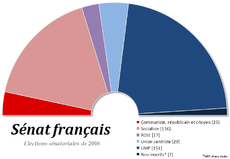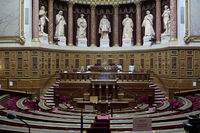Senate of France
| Senate of France Sénat |
|
|---|---|
| Type | |
| Type | Upper house |
| Leadership | |
| Président | Gérard Larcher, UMP since 1 october 2008 |
| Structure | |
| Members | 321 (343 in 2010) |
 |
|
| Political groups | Union for a Popular Movement (151) Socialist (115) Centrist union (29) Communist, republican, citizen and of the senators of the Left party (24) European Democratic and Social Rally (17) Non-Attached Members (7) |
| Election | |
| Voting system | Indirect election |
| Last election | 21 September 2008 |
| Meeting place | |
 |
|
| Luxembourg Palace, Paris | |
| Website | |
| http://www.senat.fr | |
| France |
 This article is part of the series: |
|
|
|
Constitution
Parliament
Judiciary
Political Parties
Elections
Foreign Policy
Related issues
|
|
Other countries · Atlas |
The Senate (French: Sénat) is the upper house of the Parliament of France, presided over by a president.
The Senate enjoys less prominence than the lower house, the directly elected National Assembly; debates in the Senate tend to be less tense and generally enjoy less media coverage.
Contents |
History
France's first experience with an upper house was under the Directory from 1795 to 1799, when the Council of Ancients was the upper chamber. There were Senates in both the First and Second Empires (the former being known as the sénat conservateur, the latter as the French Senate), but these were only nominally legislative bodies - technically they were not legislative, but rather advisory bodies on the model of the Roman Senate.
With the Restoration in 1814, a new Chamber of Peers was created, on the model of the British House of Lords. At first it contained hereditary peers, but following the July Revolution of 1830, it became a body to which one was appointed for life. The Second Republic returned to a unicameral system after 1848, but soon after the establishment of the Second French Empire in 1852, a Senate was established as the upper chamber. In the Fourth Republic, the Senate was renamed the Council of the Republic, but its function was largely the same. With the new constitution of the Fifth Republic enforced on October 4, 1958, the older name of Senate was restored.
Composition and election
Until September 2004, the Senate had 321 senators, each elected to a nine-year term. On that date, the term was reduced to six years, while the number of senators will progressively increase to 346 in 2010 to reflect changes in the country's demographics. Senators were elected in thirds every three years; this will also change to one-half of their number every three years.[1]
Senators are elected indirectly by approximately 150,000 local elected officials ("grands électeurs"), including regional councilors, department councilors, mayors, city councilors and their delegates in large towns, and deputies of the National Assembly. This system introduces a bias in the composition of the Senate, which favors rural areas. As a consequence, while the political majority changes frequently in the National Assembly, the Senate has remained politically conservative since the foundation of the Fifth Republic, much to the displeasure of the Socialists,[2]and some analysts are expecting that it will remain so in the forthcoming years. This has spurred controversy, especially after the September 2008 senatorial elections[3] in which the (left-wing) Socialist party, despite controlling all but two of France's regions, a majority of départements, and communes representing more than 50% of the population, still failed to achieve a majority in the Senate.
Twelve senators are elected to represent French citizens living outside the Republic.[4]
Following from a tradition started by the first National Assembly during the French Revolution, the "left-wing" parties sit to the left as seen from the president's seat, and the "right-wing" parties sit to the right, and the seating thus indicates the political spectrum as represented in the Senate.
Composition and membership
| Parties and coalitions | Abbr. | 2004 | a | 2008 | ± | |
|---|---|---|---|---|---|---|
| Union for a Popular Movement (Union pour un mouvement populaire) | UMP | 159 | 56 | 151 | –8 | |
| Centrist Union-UDF (Union centriste–Union pour la démocratie française) | UC-UDF | 30 | 4 | 29 | –1 | |
| Total "Presidential Majority" (Right) | 189 | 60 | 180 | –9 | ||
| Socialist Party (Parti socialiste) | PS | 95 | 29 | 116 | +21 | |
| Communist, Republican and Citizen (Communiste, républicain, et citoyen) | CRC | 23 | 3 | 23 | +0 | |
| Total Left | 118 | 32 | 139 | +21 | ||
| European Democratic and Social Rally (Rassemblement démocratique et social européen) | RDSE | 17 | 8 | 17 | +0 | |
| Non-Inscrits | NI | 6 | 1 | 7 | +1 | |
| Total | 331 | 114 | 343 | +12 | ||
| a - Seats up for election (Serie A) Source: Public Senat |
||||||
President
Senators elect among themselves a President. The current incumbent is Gérard Larcher. The President of the Senate is also, according to the constitution of the Fifth Republic, first in line of succession in case of death, resignation or impeachment (only for health reasons) of the President of the Republic, thus becoming Acting President of the Republic until a new election can be held. This happened twice for Alain Poher, once at the resignation of Charles de Gaulle and once at the death of Georges Pompidou.
Powers
According to the Constitution, the Senate has nearly the same powers as the National Assembly. Bills may be submitted by the government (projets de loi) or by either house of Parliament (propositions de loi). However, if the National Assembly and the Senate cannot agree upon the language of a bill, the Government can ask the National Assembly to make a final vote on the bill, either using the original version that the National Assembly voted on, or the edited version adopted by the Commission mixte paritaire and including any amendments put forth by the Senate that the National Assembly may desire to adopt.[5] During a period of social dominance, or conflictual bicameralism, the Assembly can override a Senate veto.
Because both houses may amend the bill, it may take several readings to reach an agreement between the National Assembly and the Senate. When the Senate and the National Assembly cannot agree on a bill, the government can decide, after a procedure called commission mixte paritaire, to give the final decision to the National Assembly, whose majority is normally on the government's side. This does not happen frequently: most of the time both houses eventually agree on the bill, or the government decides to withdraw it. However, this power gives the National Assembly a prominent role in the law-making process, especially since the government is necessarily of the same side as the Assembly, for the Assembly can dismiss the government through a motion of censure. The power to pass a vote of censure, or vote of no confidence, is limited. As was the case in the Fourth Republic's Constitution, new cabinets do not have to receive a vote of confidence. Also, a vote of censure can only occur after 10 percent of the members sign a petition; if rejected, those members who signed cannot sign another petition until that session of parliament had ended. If the petition gets the required support, a vote of censure must gain an absolute majority of all members, not just those voting. If the Assembly and the Senate have politically distinct majorities, it is expected in most cases that the Assembly will prevail, so that open conflict between the two houses is uncommon.
The Senate also serves to monitor the government's actions by publishing many reports every year on various topics.
Location
The Senate is housed inside the Luxembourg Palace in the 6th arrondissement of Paris, and is guarded by Republican Guards. In front of the building lies the Senate's garden, the Luxembourg Garden, open to the public.
See also
- Politics of France
- French Parliament
- French Congress
- Senators for life in France
- List of Presidents of the French Senate
References
- ↑ Les groupes politiques
- ↑ Gilles Le Béguec, Les socialistes et le Sénat, Parlement[s], Revue d'histoire politique, n° 6 2006/2, pp. 57-72, L'Harmattan, ISBN 2200921163
- ↑ http://www.liberation.fr/politiques/010132156-senat-le-triomphe-de-l-anomalie
- ↑ http://www.senat.fr/listes/senateurs_representant_les_francais_etablis_hors_de_france.html
- ↑ Article 45, Constitution of France of October 4, 1958.
External links
|
||||||||